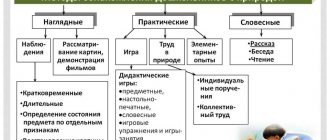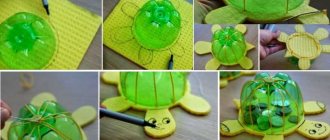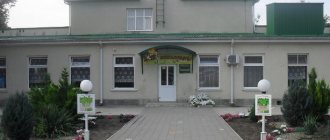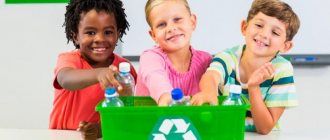Goals and objectives of environmental education for preschool children
— From simple to more complex
— From the particular to the more general
The process of forming the foundations of environmental knowledge in children can be conditionally divided into several stages, following each other or in parallel and allowing to create the most complete picture of the world. In this case, it is necessary to take into account the age characteristics and general level of development of the children in the group.
Approximate sequence for presenting environmental knowledge:
— Nature and objects made by human hands.
- Living nature: humans, all animals, all plants. Signs of a living organism: eats, breathes, moves, grows, reproduces.
— Inanimate nature is a habitat for all living things: terrestrial, underwater, air.
— Interrelation and interdependence of living beings with the environment: features of the external structure that contribute to adaptation to environmental conditions, adaptation to environmental changes by season; molting, food reserves for the winter, hibernation, leaf fall of plants, etc., ecosystems (biocenoses) and their types: ecosystems of forests, meadows, lakes, seas and others.
By daily revealing to a child the beauty, uniqueness and essence of certain natural objects and phenomena, one can form a stable interest in the surrounding nature and develop artistic and creative abilities. Observing in nature, children reflect everything they saw and felt in their drawings, crafts made from paper, plasticine, natural materials, as well as in play activities.
In the process of environmental education, children's speech develops. This is very important for every child and is especially important for children in speech therapy groups with general speech underdevelopment (GSD). This starts from the selection of adjectives when describing natural objects and ends with children inventing stories, fairy tales, and riddles on environmental topics.
When forming concepts and ideas about natural objects, about various natural phenomena, it is necessary to constantly show that in nature everything is connected, everything depends on each other. If, under the influence of some factors, changes occur in one link, then changes occur in many other links along the chain, leading to undesirable and often harmful consequences, both for nature and for man himself. By introducing children to the negative impacts of humans on nature, revealing the integrity of nature, it is necessary to instill in them a sustainable need for a caring and careful attitude towards the entire world around them, a desire to preserve and increase its wealth. If such needs are firmly established in children, then this will be the beginning of the formation of the foundations of an ecological culture in them, which is part of the general culture of a person’s personality.
Environmental education and upbringing of preschool children
Lidiya Varlamova
Environmental education and upbringing of preschool children
Municipal budgetary preschool educational institution kindergarten
"Kancheeri"
Report on the topic: “ Environmental education and upbringing of preschool children ”
Completed by: 1st category teacher
Varlamova Lidiya Borisovna
Khonuu village
Table of contents:
Introduction
1. The essence, objectives and content of environmental education for preschool children .
2. Programs for environmental education and upbringing of older preschoolers .
3. Environmental education of preschool children as a process of formation of knowledge, attitudes, and behavior.
4. Methods and forms of environmental education of children .
5. Environmental education in the classroom and in everyday life.
Conclusion.
Literature.
Application.
Introduction.
The current unfavorable environmental situation is due to the consumer attitude of man towards nature that has developed over centuries. Many scientists believe that this is a natural result of man’s ideas about himself as the (king of nature, (the inexhaustibility of natural resources, the result of recognizing only the material value of nature and the use of its wealth without taking into account the most important environmental laws . Human activity leads to an imbalance of natural forces, abilities nature to natural reproduction , which not only affects human health, but also threatens the existence of humanity as a whole.
The object of attention of many scientists, psychologists and teachers is the problem of man’s relationship to nature in the light of environmental education and training . They point to the need for greening public consciousness, which would contribute to the formation of environmentally sound behavior, reasonable needs, environmental responsibility , i.e. the formation of an environmental culture .
The formation of environmental consciousness , environmental culture is a long process that can be carried out throughout a person’s life under the influence of ideology, politics, art, scientific knowledge, industrial practice, education .
Preschool childhood can rightfully be considered the beginning of the formation of environmental , since during this period the foundation of a conscious attitude to the surrounding reality is laid, vivid, emotional impressions are accumulated that remain in a person’s memory for a long time. Knowledge of nature, activity in it, the ability to educate a child environmentally are the source of his cultural behavior in nature and caring attitude towards it.
Thus , reasoning about the environmental problem , about the importance of environmental consciousness and culture at this stage of the development of society and its interaction with nature are directly related to the practice of preschool education .
Environmental knowledge mastered by children in a preschool educational institution is the basis for subsequent environmental education at school .
1. The essence, objectives and content of environmental education for preschool children .
From the concept of general secondary environmental education in the Russian Federation “ Environmental education is understood as a continuous process of training, education and personal development , aimed at developing a system of scientific and practical knowledge and skills, value orientations, behavior and activities that ensure a responsible attitude towards the surrounding socio-natural environment and health "
The goal of environmental education for preschoolers is to form the beginnings of an ecological culture , which will make it possible in the future, in accordance with the concept of general secondary environmental education , to successfully assimilate the practical and spiritual experience of human interaction with nature, which will ensure his survival and development. This is the formation of a consciously correct attitude directly towards nature itself in all its diversity , towards people who protect and create material or spiritual values on the basis of wealth. It is also an attitude towards oneself as a part of nature, an understanding of the value of life and health and their dependence on the state of the environment. This is an awareness of your abilities to interact creatively with nature.
The tasks of environmental education are the tasks of creating and implementing an educational model that achieves obvious manifestations of the principles of environmental culture in children :
• Creating an atmosphere in the teaching staff of the importance of environmental problems and the priority of environmental education ;
• Creation of conditions in a preschool institution that ensure the pedagogical process of environmental education ;
• Systematic advanced training, mastery of environmental education , improvement of environmental propaganda among parents;
• Carrying out systematic work with children within the framework of one technology or another, its constant improvement;
• Identification of the level of ecological culture of real achievements in the intellectual, emotional, behavioral spheres of the child’s personality in its interaction with nature, objects, people and self-assessments.
The content of environmental education includes two aspects: the transfer of environmental knowledge and its transformation into attitude. Knowledge is its obligatory end product. Truly ecological knowledge forms a conscious attitude and gives rise to environmental consciousness .
in environmental education :
— scientific and educational;
— value;
— normative;
- practically - active.
The scientific-cognitive line develops preschoolers' in environmental problems and forms ideas about the picture of the world; it can be represented by material that reveals the properties of objects and phenomena, their diversity , and connections between them. attitude towards their home and natural and social environment is formed.
The value line is designed to reveal to children the multifaceted significance of the objects being studied in the life of nature and man. It is necessary to use accessible material to reveal to children the significance and value of nature, to show that nature is not only a source of life resources, it largely determines a person’s self-development and the richness of his individuality. The primary goal of this approach is education , the upbringing of a free , amateur person with a developed natural perception of nature .
The normative line of content is the rule (instructions and prohibitions)
human behavior and activities in the natural and social environment.
Children of preschool age must learn moral and ethical rules and norms in relation to people, and therefore to society, as well as a humane attitude towards natural objects.
Consequently, they are accustomed to universal human moral norms, the assimilation of which can become an indicator of the child’s general culture of behavior. The practical activity line plays an important role in the content of environmental education for preschoolers . Since in the process of practical activity the child learns what and how to do, consciousness, experience, feelings develop, and the child’s very relationship to the environment is formed and established.
In the system of preschool and school education in the Republic of Sakha (Yakutia)
two interconnected structures:
— environmental education of the moral principles of the individual;
— preschool environmental and school scientific and environmental education.
In the structure of environmental education of education are subsequently added . Every people inhabiting Yakutia has constitutional rights and obligations to preserve and enhance their national dignity and traditions. On the basis of folk customs, traditions, and oral traditions, a folk code is being formed on the moral purity of the individual on a national level. This code represents the purposeful environmental activities of people over many generations, their environmentally appropriate behavior , thrift, caring, humanism and respect for folk wisdom and the culture of their people.
In the structure of preschool environmental and school scientific and environmental education, the main ones are the combination of the principles of environmental education with the spiritual culture of the people.
In the environmental education of children of the 1st stage, it is important not only to familiarize them with natural phenomena, with the environment of their home, recognition of domestic animals and some representatives of wild flora and fauna. Attitudes about the consequences associated with bad relationships with objects of the surrounding world are very important; the development of a sense of humanity in relationships with animals and plants, the joy of communicating with them, and caring for one’s environment is carried out.
Environmental education of children at stage 2 begins with the formation of concepts of the simplest connections between observed phenomena of the year, the change of seasons, and ideas about the connection between nature and human activity. The beginning of environmental education is organized in such a way that children discover nature themselves, based on practical experience. Most of the time is devoted to observing natural phenomena (at different times of the year)
outdoors and indoors, conducting one-day field classes in nature.
of education , children should have an understanding of the photosynthetic role of plants, environmental conditions, and the cycles of substances in nature.
2. Programs for environmental education and upbringing of preschool children .
The content of environmental education for children is reflected in some modern programs of educational work with children : “Spider Web”
Zh. L. Vasyakina (1994,
“We are the earthlings”
by N. N. Veresov (1996,
“Our home is nature”
by N. A. Ryzhova (1996,
“Young
ecologist ” by S. N. Nikolaeva (1996, program
“Childhood”) "
(Russian State Pedagogical University named after A.I. Herzen
(1996)
, etc.
• Program for environmental education and upbringing of older preschoolers “Our Home is Nature”
- author, Ryzhova N. A., Doctor of Pedagogical Sciences, Moscow State Pedagogical University.
The goal of the program: to educate from the first years of life a humane, socially active, creative personality, capable of understanding and loving the world around us and nature, and treating them with care.
The program is aimed at developing a holistic view of nature and the place of man in it. Children their first ideas about the relationships that exist in nature and, on this basis, the beginnings of an ecological worldview and culture, a responsible attitude towards the environment and their health. Much attention is paid to the development in children of elementary ideas about the relationships existing in nature. Preschoolers learn to understand how closely natural components are interconnected and how living organisms depend on their environment.
Man is seen as an integral part of nature. This approach makes it possible to bring children to a basic understanding of the problem of the relationship between man and the environment and the consequences of human activities.
Great importance is attached to the moral aspect: the development of ideas about the intrinsic value of nature, an emotionally positive attitude towards it, the development of the first skills of environmentally literate and safe behavior in nature and in everyday life. Children also acquire initial skills that allow them to participate in feasible practical activities to protect the nature of their native land.
• Comprehensive regional program “Child and the whole world”
Penza
The content of the program is systematized by topics, among which the theme “Nature”
(inanimate nature; the plant world; the animal world; nature and me)
.
The objectives of work on this topic include introducing children to phenomena , objects of inanimate and living nature, the desire to take care of plants, intolerance to their senseless damage; the formation of an ecological culture , a conscious attitude towards nature, and others.
3. Environmental education of preschool children as a process of formation of knowledge, attitudes, and behavior.
The transfer of environmental knowledge is the initial stage in the procedure for developing the right attitude towards the world around us. of elements of environmental in the content of children’s activities serves as an indicator of his attitude to the natural world, things, and people to himself. Experience shows that the attitude of different children is heterogeneous : the cognitive, aesthetic and humanistic components may predominate in it.
The predominance of the cognitive aspect in relation is a pronounced interest in phenomena and events in nature.
We can talk about the aesthetic orientation of the relationship if the child’s attention is focused on external (sensory)
qualities of a phenomenon, which entails value judgments.
With a clearly expressed humanistic orientation of the relationship, there is sympathy, concern, and readiness to help.
The child’s independent activity is carried out without coercion, is accompanied by positive emotions and is an interpretation of the learned information.
In the process of environmental education, the following types of activities take place:
- role-playing game reflecting various events in nature and the nature-creating activities of adults;
- practical activities to create or maintain conditions for living objects in the green area of the kindergarten (work in nature, also activities to restore objects (repairing toys, books, etc.)
;
-creation of art products based on impressions of nature or people’s activities in nature;
-communication with nature, voluntary contact with objects of flora and fauna - complex activities, including observation, evaluative one-sided judgments, caressing, grooming, training and training;
-experimentation: practical cognitive activity with natural objects, accompanied by observation and statements;
-speech activity (questions, messages, participation in conversation, dialogue)
;
-exchange of information, impressions, clarification of ideas about nature using words;
— observation is an independent cognitive activity that provides information about the nature and activities of people in nature;
- viewing books, paintings, television programs with natural history content - activities that contribute to obtaining new and clarifying existing ideas about nature.
Observation of children's and analysis of their content make it possible to discover their individual characteristics and level of environmental awareness .
4. Methods and forms of environmental education of children .
Environmental education uses various forms and methods of organization and teaching. I conduct classes or excursions with all children (front form)
or with subgroups
of children .
It is better to organize work and observations of nature with a small subgroup or individually. Teaching methods are ways of joint activities between the teacher and children , during which the formation of knowledge, skills and abilities is carried out, as well as the development of attitudes towards the world around them. In my work I use visual, practical and verbal methods.
Visual methods include observation, looking at paintings, demonstrating models, films, and transparencies. Visual methods most fully correspond to the possibilities of cognitive activity of preschool children and allow them to form vivid, concrete ideas about nature.
Practical methods are games, elementary experiments and modeling. The use of these methods makes it possible to clarify children's , deepen them by establishing connections and relationships between individual objects and natural phenomena, systematize the acquired knowledge, and train preschoolers in applying knowledge .
Verbal methods are stories from the teacher and children , reading works of art about nature, conversations. I use it to expand children's knowledge about nature , systematize and generalize it. Verbal methods help to form in children an emotionally positive attitude towards nature.
When working on environmental education of children, it is necessary to use different methods in a complex and correctly combine them with each other. For example, the formation of knowledge about the lifestyle of birds is impossible without observations; children learn about ways to care for indoor plants in the process of work; about the properties of snow and ice - during experiments or games. Knowledge about wild animals is formed during reading or storytelling.
5. Environmental education in the classroom and in everyday life.
In the preparatory group for school, the focus is on the work of generalizing and systematizing children to better navigate their surroundings. The assimilation of knowledge of this nature is due to the further development in older preschoolers of a whole system of cognitive skills, such as the ability to analyze an object or phenomenon, compare, generalize according to selected features, and the ability to establish connections between facts.
Solving these complex problems requires a system of specially organized classes and the creation of the necessary conditions. In the group, I created a corner of nature with indoor plants (violet, chlorophytum, impatience, wild rose, aspidistra, where children learn to care for and observe the growth and development of plants. Care consists of their timely watering, spraying, washing, as well as loosening the soil, replanting, pruning, propagation and pest control.Also in the corner there is a nature calendar, an observation album, natural materials for classes, a herbarium of local plants, didactic and board games, and exhibitions of children's made from natural materials.
Along with classes in which specific ideas about animals, plants, and natural phenomena are formed, classes that generalize children’s . They are carried out using the method of conversation, comparative and generalizing observations, and excursions. Classes in which the development of vocabulary and coherent speech contribute to the identification of signs, properties of natural objects, connections and relationships between them, increase the degree of awareness of the acquired material.
When solving a more complex cognitive task that requires the deployment of some system of evidence for a certain position, activities, combined with other forms of work, constitute elementary search activity. For example, in order to determine whether a plant is a living organism, I conduct a lesson on forming the concept of living and identifying the main features that distinguish living from non-living. When examining a plant together with children, we determine the presence of the main organs, their integrity, the condition of the plant, the conditions in which it is located. In conclusion, a conversation is held in which it is established that this plant is a living one. The organization of elementary search activities stimulates children's interest in nature and activates them.
By the age of 6-7, preschoolers have some experience of cognitive activity, and conditions are created for the formation of cognitive interests. This is achieved by gradually increasing the complexity of cognitive tasks, using a variety of active methods and techniques in the classroom. The task can be posed in a game form. For example, Dunno decided to settle all domestic animals in the forest; During the lesson, children prove why this should not be done.
Another important requirement for classes is the organization of active activities with understandable handouts. Elements of independence and creative thinking are actively developed in the classroom if contradictory or problematic situations are used. For example, to form the concept of “plants”
, we can ask the question: is a seed a plant or not?
When clarifying the concept of “pets”
, ask whether a fly or mouse belongs to them.
In the preparatory group, questions are the core that determine both the logic of the lesson and the nature of the cognitive activity of preschoolers . The main place should be occupied by those that require children to think , establish cause-and-effect relationships, and be able to use ideas acquired in everyday life in the classroom. However, questions and tasks of this type should follow those that are aimed at identifying specific characteristics of objects and phenomena. This increases the degree of awareness of the material being absorbed and creates the necessary basis for independent conclusions.
It is important that children not only acquire knowledge about nature, but also learn to ask questions, independently search for an answer, using the ability to examine an object or compare it with another, comparing it with the conditions in which the object lives, etc. in connection with These are appropriate questions for children, for example: How did you know? How to prove this? How can I check?
A significant place in working with children is occupied by methods such as modeling, experiments based on the activity and growing independence of cognition of a preschooler .
In the preschool group, the content of work with children in everyday life becomes more diverse and complex . This is due to the increased cognitive capabilities of preschool children . In natural conditions (on the site, in the forest, in the field, in the garden, etc.)
Children are shown
the diversity of plants and animals , vivid manifestations of their vital activity, and are given knowledge about the specific relationships between living and nonliving things.
It is necessary to conduct targeted walks and excursions, organize systematic observations and experiments, basic search activities, actively include in the knowledge of natural phenomena the practical activities of preschoolers , and above all the work of growing plants and caring for them, for example, in the spring we grow seeds of oats, vegetable crops (tomatoes) , cucumbers, and in the summer we also plant annual marigolds, asters, calendula, petunia and other flowers in the flower garden of the kindergarten.
Conclusion.
The main result of children mastering environmental knowledge is the development of environmental (humane, environmental)
attitude towards nature, manifested in responsibility for the life of a living being, anxiety, sympathy, compassion, and the desire to help.
The need to put a child in an active cognitive position when mastering an environmental education leads to the development of cognitive interest, to independent development and use of various methods of cognition.
The possibility and success of studying the laws of nature in preschool childhood within the framework of environmental education and upbringing has been proven by numerous psychological and pedagogical domestic studies. Systematic work on environmental education should be carried out both in preschool educational institutions and in the family. It should be understood that the result of upbringing does not appear immediately, the effect of pedagogical efforts is to evoke positive emotions in the child, to leave vivid impressions in his soul that will carry him through life, like memories of joyful and wonderful communication with nature.
Literature.
1. Vinogradova N. F., Kulikova T. A., “Children, adults and the world around”
,-M,: Education, 1993.-128 p.
2. Bogdanets T. “ Ecological knowledge is the first idea of the world”
.//
Preschool education .
No. 12, 2003. 3. Nazarova L. D. “ Ecology of the soul : the formation of a person’s moral position in relation to the world.” // Management of a preschool educational institution . No. 3, 2007.
4. Nikolaeva S. N. “How to introduce a child to nature”
: Methodological material for working with parents in
a preschool institution , - M,: New School, 1993.-64 p.
5. Nikolaeva S. N. “ We cultivate love for nature from childhood ”
.
Recommendations for teachers, parents, tutors.”-M,: “Mosaic-Synthesis”
, 2004.-112 p.
6. Potapova T.V. “ Ecological and educational work in kindergarten”
.
// Management of a preschool educational institution .
No. 2, 2005. 7. Ryzhova N. A. “On environmental education programs for preschool children .” // Preschool education . No. 11(131, 2004.
8. “Theory and methodology of environmental education for preschool children ”: Proc. -method. Complex/ Institute for Educational , YSU PI: comp. L. I. Maksimova. – Yakutsk, 2002.-120 p.
Aspects of activity
The goal of environmental education can only be achieved if the educator is interested in this issue. It is the teacher who is the main figure in the pedagogical process and makes a decisive contribution to the environmental education of the younger generation.
The main aspects of his personality characterize the possibility of forming in preschool children the foundations of a respectful attitude towards the biosphere:
- awareness of the problem, a sense of civic responsibility for the current situation, a desire to contribute to changing it;
- pedagogical skill and professionalism, mastery of methods for developing love for the world of animals and plants in young citizens, systematic implementation of technology in practical activities when raising children, creative search in its improvement;
- practical implementation of the humanistic educational model in order to cultivate an ecological culture.
The teacher must create a favorable atmosphere for children to be in kindergarten and take care of the mental and physical health of children. The use of personality-oriented educational methods, individualization of work with students and their parents is the main goal of environmental education.
Concepts of environmental education by Fedoseeva
According to teacher P. G. Fedoseeva, the goal of environmental education in preschool education is to form a basic ecological culture, and on its basis to develop in preschoolers an emotional, moral, scientific, cognitive, practical and active attitude towards living nature.
Love for native nature and a caring attitude toward it are formed in a child’s soul only when the child constantly sees examples of such an attitude on the part of the teacher, parents, and grandparents.
Ecology
The key component of the concept of “ecology” is “interaction”, “connection”. Initially, since the time of E. Haeckel, who first introduced this term in 1864, and for a long time after that, ecology designated the field of knowledge about the connections of living organisms - plants, animals, their communities - with the environment, i.e. it was a section biology. Later, this concept began to expand to include humans.
At the present stage, ecology can be defined as a science that examines the relationship of living organisms, including humans, and their communities with the environment.
At the same time, the environment can be understood as both the natural environment and the environment as a whole (natural, social, material). In the first case, we talk about ecology in a narrow sense, in the second - in a broad sense.
In environmental education of children, as a rule, they are limited to ecology in the narrow sense, i.e. consider the relationship between man and the natural environment. And this is correct, otherwise the objects to which children’s attitudes are formed become blurred, and there are too many of them. And the environmental problem itself arose precisely because the natural environment began to be destroyed as a result of human activity.
So, the concept of “ecology” includes two components: nature as biological objects, as the natural environment and the connections between them. Consequently, preparing a preschooler for subsequent full mastery of ecology includes:
- a) the formation in children of ideas about objects of environmental interaction - objects of nature, and first of all about plants and animals (and this is natural science);
- b) the formation of ideas about connections, without yet dividing them into natural, environmental or other connections.
The study of relationships (cause and effect) in preschool education is currently receiving the necessary attention, but this is not always connected with environmental education. Whereas in the educational system “School 2100” this area of work is directly tied to it. As the authors of the textbook “Hello, World!” note, they begin environmental education with the idea formulated by ecologist Barry Commoner: “everything is connected to everything” [1]. And this is the beginning of the formation of an appropriate universal educational action, defined in the Federal State Educational Standard for primary education as “identifying cause-and-effect relationships.”
However, there is an aspect in the Federal State Educational Standard for Education that is directly related to environmental education. One of the tasks there is formulated as follows: “development of emotional and value perception... of the natural world.” This task is implemented within the framework of environmental education, since the formation and development of emotional and value relations towards nature belong to the sphere of environmental education. And an emotional-value attitude is possible if children have ideas (knowledge) about nature as something valuable, i.e. elements of environmental education should also be present here.
Purpose
Taking into account the new educational standards, we can note the goals and objectives of environmental education of children:
- creation and successful implementation of an educational and upbringing model that allows achieving the effect of showing respect for nature among preschoolers;
- creating an atmosphere of importance and significance of environmental problems in the teaching staff;
- the formation in an educational preschool institution of conditions that allow the implementation of environmental education for preschool children;
- constant improvement of their qualifications by teaching staff, mastering by teachers of new methods of environmental education, raising the level of culture of parents of preschool children;
- conducting ongoing work with children within the framework of certain methodological technologies;
- diagnostics of the development of skills of caring attitude towards the living world in preschool children;
- drawing up plans for environmental education based on the results obtained.
Children aged 4-6 years have certain age-related characteristics, which is the basis for the formation of worldviews and gives the teacher enormous opportunities for environmental education.
Content selection
In order to realize the goals of environmental education of schoolchildren and preschoolers, it is important to select the content of education. In this case, environmental knowledge will become the basis for fostering a culture of respect for living nature. They will help to form a certain system of values in the younger generation, to create an idea of man as an integral part of nature.
The task of the teacher is to develop in students a sense of responsibility for their lives and health.
Specifics of environmental education in preschool educational institutions
It is part of the educational process that promotes the development of speech, logical thinking, erudition, and emotionality in preschool children. The use of such methods in preschool educational institutions contributes to the moral education of preschoolers and allows them to develop a harmoniously developed personality.
The goal of environmental education of children is to master the norms of safe behavior based on the simplest knowledge, and to understand the importance of caring for the living world.
Environmental education and self-development of preschoolers
If a teacher uses in his work methods that are based on the emotionality of the child - his ability to be surprised, sympathize, empathize, show concern for the people around him, plants, animals, see the beauty of the landscape, this will allow him to achieve his goal - to educate a harmoniously developed personality.
The teacher places emphasis in his work on developing the skills of caring for the living world, developing work skills, and introducing preschool children to plants and animals common in a particular area. Children not only receive theoretical information, but also practice their acquired knowledge in the process of caring for flowers on the site and animals in the living area.
When working with preschool children, teachers try to pay close attention to conducting experiments and experiments, involving their students in project and research activities in the field of ecology.
For example, children of senior preschool age first get acquainted with the birds that live in their region, then together with their parents they make feeders and observe feathered pets.
Features of N. A. Ryzhova’s method of eco-development for preschoolers
According to the author, the ecological culture of preschool children can be characterized as “a certain level of a child’s perception of the surrounding world, nature, and assessment of his position in the ecosystem.”
Thanks to the preschooler’s assimilation of environmental and moral rules of behavior in nature, it is possible to establish correct and safe relationships with the nature that surrounds him in his native village, town, or city.
That is why it is so important to include an emotional component in the process of educating preschool children’s ecological culture, to select methods and means that effectively influence the motivational and moral spheres of the child’s personality.






